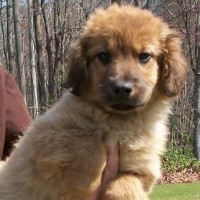Appearance of the Chow Hound
|
| Although the appearance of your Chow Hound hybrid may take on the physical appearance attributes of one or both of the parent breeds, it will probably have a brown or brindle coat that is soft and teddy-bear-like with a body that is likely to be long and stocky like the Basset parent. His ears will be of medium length and drooping and a shorter muzzle than the Basset parents with a shorter dewlap with a speckled tongue and saber-shaped tail. Other colors your dog could inherit are the Basset parent's tricolor (black, white and tan or lemon and white or red and white) or the Chow Chow parent's colors (cream/white, fawn, red, blue or black). Other possible appearance traits: eyes may be almond- or pellet-shaped and dark in color, a scissor bite and feet that are either large and well padded, or small and round with good padding. Coats of both parent breeds are moderate excretors and will probably require moderate levels of grooming maintenance, mainly a contribution from the Chow Chow side of the equation. |
Temperament of the Chow Hound
|
| The Chow Hound hybrid has been described as intelligent, friendly and an excellent family dog. If your pet inherits the personality traits of the Basset Hound parent, it could be affectionate, alert, friendly, gentle and kind. If he inherits the personality traits of the Chow Chow parent, he could be aggressive, alert, detached, independent, intelligent, loyal, protective and quiet. Both parent breeds are considered occasional barkers with moderate levels of hunting and wandering tendencies. The Basset parent breed is good with children and cats and for new owners, but the Chow Chow parent is at the opposite end of the spectrum in these areas. Both parent breeds contribute to a difficult biological mix training, requiring a lot of patience and perseverance and perhaps even obedience training to get the job done. In the area of exercise, both parent breeds contribute lower energy levels to the biological mix. Although both parent breeds have a strong tendency to gain weight, the actual exercise requirements are lower than those of other, higher-energy breeds. You should expect your pet to be wary of strangers due to the protective contribution of the Chow Chow parent. |
Needs and activities of the Chow Hound
|
| Your Chow Hound hybrid will need 40 to 80 minutes of daily exercise to stay fit, healthy and avoid obesity. He'll be quite happy to lie in front of the fireplace or curl up on that thick, fluffy rug and sleep all day, but these activities aren't healthy for him. Daily walks in the park or around the block will suit him fine, but be aware that a hound's nose can pick up an interesting scent anywhere at any time, stimulating him to follow and investigate without any thought or concern for obeying your "come" command as he runs. To avoid the inevitable chase, keep him on a leash when you take your dog out for exercise. If you have a fenced yard, make sure it's secure, as the Chow Hound can be quite the escape artist. This hybrid is well suited to life in apartments, condominiums or family homes, provided adequate exercise can be provided. It will adapt to both urban and rural areas, and can tolerate both warmer and cooler temperatures, depending on the thickness and density of the coat it inherits. |
Maintenance of the Chow Hound
|
| Your Chow Hound hybrid will probably require some grooming, the type and frequency of which will depend on the amount of coat provided by the Chow Chow parent and the season of the year. The Basset parent has a low-maintenance coat, requiring only a weekly brushing and bath as needed, while the Chow Chow parent's longer, denser coat requires more frequent brushing and bathing (several times a week, once a month or more often if necessary) to keep it clean and beautiful, reducing the "doggy" smell that can accompany dog ownership. Neither parent breed is hypoallergenic, and the floppy ears brought by the Basset parent will require frequent checking and cleaning to prevent infection. Both breeds require regular teeth cleaning and oral examinations to prevent periodontal disease, which can lead to tooth loss. |









 English (United Kingdom)
English (United Kingdom)